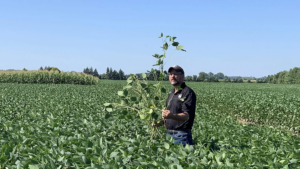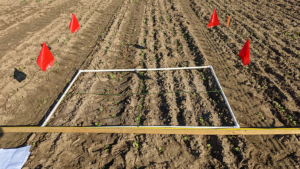Breeding innovations
OAT AND SOYBEAN VARIETY DEVELOPMENT

THE OAT BREEDING program at Agriculture and Agri-Food Canada’s Ottawa Research and Development Centre, led by Dr. Weikai Yan, has been working on a project to boost yield, quality, and disease resistance in new oat cultivars.
Eastern Canada has two contrasting mega-environments that require very different oat cultivars to maximize grain yield. The project aims to develop and deploy oat cultivars that best suit those mega-environments in terms of yield, quality, and disease resistance. Mega-environment 1 includes the crown rust-prone regions of southern Ontario, while mega-environment 2 includes the northern regions of eastern Canada.
According to Yan, the project had a number of objectives beyond boosting grain yield, including improving lodging resistance and boosting crown rust resistance for southern Ontario. The project also aimed to improve milling and composition quality, including groat, beta-glucan, oil, protein, and ease of dehulling, as well as grain quality, including kernel weight, test weight, plumpness, uniformity, and hull colour.
Finally, the current project also includes an agronomic study led by Dr. Baoluo Ma to explore best agronomic practices to maximize yield, quality, and lodging resistance.
NEW VARIETIES RELEASED
Two new varieties were released in 2022. AAC Dehaan (OA1644-13) was released for mega-environment 1, which is high-yielding, high quality, early maturing, and offers good lodging resistance. “It is so far probably the best variety we’ve developed,” Yan said.
AAC Dehaan is also moderately resistant to crown rust, a constant problem in southern Ontario. Without crown rust resistance, growers are looking at a 25 per cent yield loss. Currently, most growers apply fungicides two times each season to address crown rust issues, but with the new crown rust resistant cultivars, Yan said they might only need to spray once, which could save up to $75/ha.
The second release, AAC Wight, is more suitable for northern Ontario. It is higher yielding than AAC Nicolas and offers better quality in terms of test weight and beta-glucan, but no crown rust resistance, as crown rust is not an issue in that region.
“Higher yielding cultivars are more demanding in terms of lodging resistance,” says Yan, adding that these new cultivars offer a nice balance between the two.
Yan’s program aims to release at least one new cultivar for mega-environment 1 and two new cultivars for mega-environment 2 in early 2023.
FOOD-GRADE SOYBEANS
Each year, demand for non-GM, food-grade soybeans makes up about 25 – 30 per cent of the total market share in Ontario and Quebec, according to University of Guelph breeder Dr. Istvan Rajcan. To meet this demand, he is continuously developing new high-yielding, disease-resistant, value-added soybean cultivars for the Maturity Group 1-00 growing regions.
New soybean varieties developed within his program incorporate elite Canadian and exotic source material to enhance yield. New cultivars offer enhanced value and opportunities for value-added markets, including improved tofu and soymilk properties, higher sucrose content, saponin, isoflavones, and modified oil profiles for the health foods and bio-products markets.
Finally, new cultivars offer improved genetic resistance to soybean cyst nematode (SCN) and better resistance to white mould.
Rajcan’s breeding program annually releases 3 – 5 new soybean cultivars that meet grower demand. The new cultivars are high yielding and high in protein, which makes them suitable for the food-grade market.
“In recent years, we switched our focus towards the development of soybean cyst nematode resistance in all of our new cultivars,” says Rajcan. “It used to be an optional trait for my target region in southern Ontario. We have stopped selecting material that didn’t have resistance because the market demands it.”
“SCN is not in every county of Ontario,” he adds. “But it is in enough counties of my target region that I cannot afford not to include that trait in the new cultivars.”
Rajcan’s program is also working diligently on developing cultivars with white mould resistance. “It’s a difficult target because white mould is sporadic,” he says. “When it comes, it can hit the crop hard and cause major yield losses, especially in susceptible cultivars.”
To address this issue, graduate student Deus Mugabe, under the supervision of Rajcan, is evaluating the genetic causes for white mould resistance in Ontario soybeans. Mugabe has evaluated the population by inoculation and isolating DNA from the population. The isolated DNA has been sent for genotyping.
“When we get that genetic data back, we will be able to put it together with phenotypic data for resistance and identify the genetic loci or quantitative trait loci that are causing resistance,” Rajcan explains. “So, in the future, we can select for resistance in the lab without having to expose the material always to the fungus.”
Another aspect of the project is increasing the diversity of soybean varieties. To do this, Rajcan is crossing elite Canadian germplasm with modern Chinese genetics.
“The genetics of North American soybeans is known to be narrow,” he explains. “By crossing with Chinese cultivars, we’re trying to incorporate new yield, seed quality, and resistance genes into the breeding program.”
“There’s a constant concern by breeders that a narrowing of the genetic diversity in a genetic pool may lead to a plateau in breeding, which means we keep doing the same thing, but there’s no more increase in yield in the progeny,” he adds.
That has not happened so far, but Rajcan says he wants to be proactive.
Rajcan’s breeding program recently released several new cultivars that show great promise. Two of note include OAC Kamran, suitable for Maturity group 0, and OAC Aberdeen, suitable for Maturity Group 1. Both are SCN-resistant and high yielding and offer high protein.
Dr. Yan’s oat breeding program at AAFC Ottawa and Dr. Rajcan’s soybean breeding program at the University of Guelph are funded in part by the Government of Canada under the Canadian Agricultural Partnership’s AgriScience Program, a federal, provincial, and territorial initiative. •

























